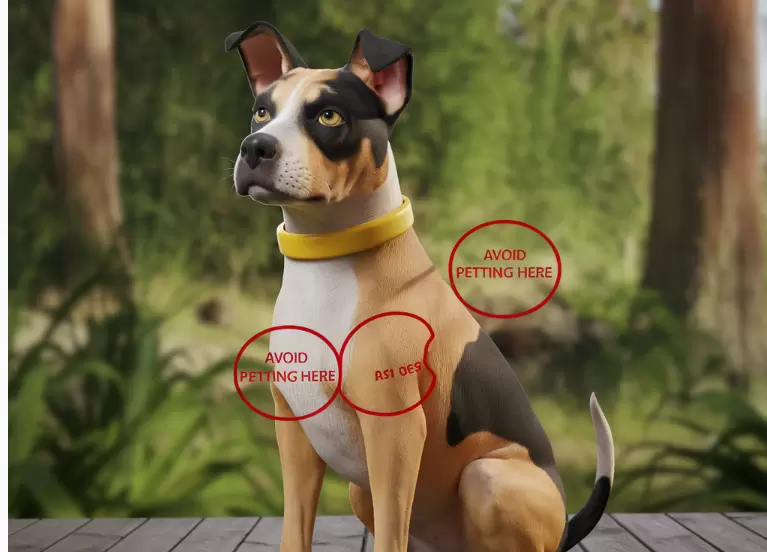The well-being of people is dependent on learning how to pet a dog safely. Petting a dog in the right way means that you build trust and not only show love to it. This guide will help you understand this process well as such.
You will get to know what to do and what not to do, therefore, creating a good relationship with your dog friend. Mastering the art of safe petting is for having both yourself and the dog enjoy whenever you are in contact through hands.
Understanding the Importance of Safe Petting
Firstly, let’s understand why it’s essential prior to getting into the details on how to safely pet a dog. When you pet a dog safely, you’re:
- Respecting the dog’s boundaries
- Decreasing the odds of unfavorable responses
- Improving the Connection Between Man and Dog
- Promoting positive associations with human touch
For you to be able to safely caress a dog, it is essential that you know how a dog acts and respects personal choices. This should remind you that dogs do not like being petted in similar ways or at identical spots.
Reading Canine Body Language: The First Step to Pet a Dog Safely
To pet a dog safely, you must first learn to read their body language. Here are some key signals to watch for:
| Signal | Meaning |
| Relaxed, open mouth | Content and approachable |
| Tail held high and wagging | Excited and friendly |
| Ears pinned back | Fearful or submissive |
| Raised hackles | Aroused or fearful |
| Whale eye (showing whites of eyes) | Anxious or uncomfortable |
For you and your dog to have a positive interaction, it is very important that you understand these signals so that you can pet a dog safely.
The Do’s and Don’ts of How to Pet a Dog Safely
Here’s a quick reference guide on how safely touch dogs:
Do’s:
- Always ask the owner’s permission before you pet a dog safely
- Let the dog approach you first
- Start by offering your hand for the dog to sniff
- Pet gently and watch for signs of enjoyment or discomfort
Don’ts:
- Don’t pet a dog without permission
- Avoid sudden movements that might startle the dog
- Don’t force interaction if the dog seems uninterested or uncomfortable
- Avoid petting from above or reaching over the dog’s head
Safe Petting Zones: Where to Pet a Dog Safely
As much as training a dog may seem straightforward, there are certain areas of a pet’s body you should touch gently. Here’s a guide to the canine-approved petting zones:
- Chest: This area’s a winner for most pups. When you pet a dog safely on the chest, you’re in their line of sight, which helps them feel secure. Use gentle, circular motions and watch their tail for signs of enjoyment.
- Behind the ears: Talk about a sweet spot! This area’s packed with nerve endings, making it extra pleasurable for many dogs. Start with light scratches and adjust based on the dog’s reaction. Some might lean in for more, while others prefer a gentler touch.
- Base of the tail: For many dogs, this is the jackpot of petting zones. When you pet a dog safely here, you might notice their leg start to twitch – that’s a good sign! But proceed with caution; some dogs find it over stimulating.
- Along the neck: Along the neck sides, you have soft, gentle strokes that can be very relaxing. This is similar to how they would have received grooming from their mothers or littermates. When you pet a dog safely in this area, you’re tapping into their comfort zone.
- Shoulders: Many dogs enjoy a good shoulder rub. It’s a pretty harmless place that they can monitor easily. Start with light pressure and see how they respond.
Remember, even these “safe” zones can vary from dog to dog. The key to petting a dog safely is always watching their body language.
You’re doing excellent if they lean in towards or nudge against your palm. On the contrary, if they are going away from you or display unease that’s the time to stop. Since each dog is different, allow them to show you where to pet them.
Areas to Avoid When You Pet a Dog Safely

When it comes to petting the dog, being aware of the dog’s no-go zones is equally important as knowing the sweet spots for petting the dog. According to this post are no petting zones:
- Top of the head: Although well-known, it might surprise you that the majority of dogs dislike head parts. It can feel threatening, like a looming presence. Instead of reaching over, try scratching under the chin for a more positive experience.
- Paws and legs: These areas are often off-limits when you pet a dog safely. They’re sensitive and many pups prefer to keep them to themselves. Take it as an act of consideration for their personal boundaries – you wouldn’t like it if some random person came and took hold of your leg limbs, would you?
- Face and muzzle: Moving closer to a dog’s face can be dangerous. Their snout is their primary sensory tool, and getting handsy here might feel invasive. When you pet a dog safely, it’s best to let them initiate any face-to-face contact.
- Belly: It’s confusing here. Some pups enjoy having their bellies scratched, but mean other dogs find themselves feeling more open to possible dangers when lying on their backs. Be on the lookout for clues from how they move or act. If they roll over voluntarily, it might be an invitation. But if you’re unsure, stick to safer spots.
Remember, every dog is unique. What some dogs enjoy, others could detest. The secret behind safe dog petting is in always understanding their signals and honoring their limitations. If unsure, allow the dog to show you where they like being petted most.
Special Considerations to Pet a Dog Safely
When it comes to learning how to safely pet a dog, it’s important to note that every dog has its requirements. For instance, puppies need one-on-one interaction, whereas older dogs demand more affection and care. Rescue dogs are also special breeds that deserve distinct treatment.
Puppies
For puppies, gentle touches are key when you pet a dog safely. Use soft strokes and pair them with treats or praise. This helps build positive associations with human touch, setting the foundation for a lifetime of safe interactions.
Senior dogs
Senior dogs often face health challenges that can make certain touches uncomfortable. To pet a dog safely in their golden years, be extra gentle and attentive to their reactions. Focus on areas they enjoy and avoid any spots that seem to cause discomfort.
Rescue dogs
Rescue dogs may have a history of negative experiences with human touch. When you pet a dog safely from a shelter, patience is paramount. Let the dog set the pace for interactions. Start with a calm presence, allowing the dog to approach you. When they do, begin with gentle touches in non-threatening areas like the chest or sides.
Though each pup comes from different homes, you can pet a dog safely if you always pay attention to its body language. Hence, it creates a good experience for all involved, enhancing trust and deepening the relationship between you two.
Frequently Asked Questions (FAQs):
Q: How often should I pet my dog?
A: It varies by individual dog. Some enjoy frequent petting, while others prefer less. Observe your dog’s reactions and respect their preferences for interaction frequency.
Q: Can petting help calm an anxious dog?
A: Well, when conducted correctly, tender stroking may ease panic-stricken pooches. Focus on slow, rhythmic strokes in areas they find comforting, like the chest or back.
Q: Is it safe to pet a service dog?
A: Generally, you should not pet service dogs without permission. They are working and need to focus on their tasks. Always ask the handler first.
Q: How can I teach children to pet dogs safely?
A: Teach kids to ask permission, approach slowly, and let the dog sniff their hand first. Supervise interactions and show them how to pet gently on safe areas like the chest.
Q: Can petting help with dog training?
A: Certainly. Petting can serve as a positive reinforcement strategy in training. However, use it to encourage the right behavior, taking into account the timing and how comfortable the dog is.
Conclusion: Mastering How to Pet a Dog Safely
For any person or cat owner, learning how to safely stroke a dog is essential. This involves understanding how dogs communicate through their bodies, giving them some space when they need it, and knowing the right places to stroke them carefully.
Creating a solid bond between humans and dogs entails petting them in a safe manner. But remember, every dog is different! What one dog loves might not work for another.
To pet a dog safely, always watch how the dog reacts. If they seem happy, great! If not, try something different. It’s cool to vary your petting style according to their preferences.
The more practice you put into it, the more proficient you will be in making sure that your dog receives safe petting. Eventually, after lots of hard work, you can learn to caress them in the right way and take pride in yourself along with your companions!

Edward Charlie has been a dedicated blog writer since 2008, amassing 16 years of experience in the field. Throughout his career, he has developed a keen ability to craft engaging, well-researched content that resonates with a diverse audience. Edward’s extensive background has allowed him to master various blogging niches, from technology and lifestyle to science and culture. His commitment to quality writing and insightful analysis has not only refined his skills but also earned him a reputation as a trusted voice in the blogging community. Passionate about his craft, Edward continues to explore new topics and trends, delivering content that informs and captivates his readers.